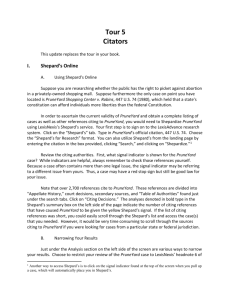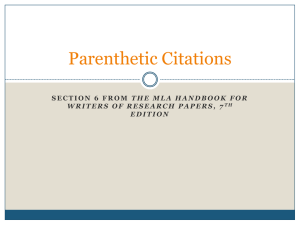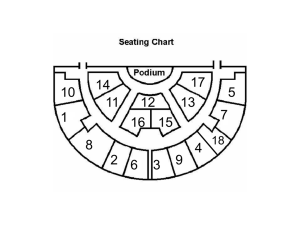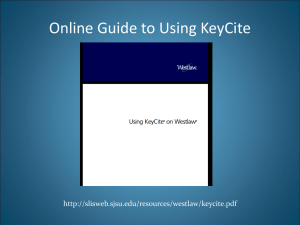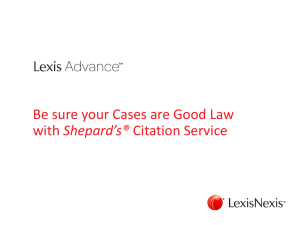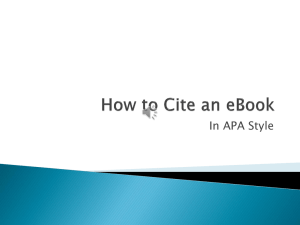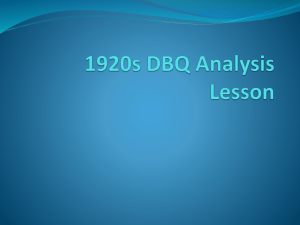Getting the Most Out of Shepard`s
advertisement
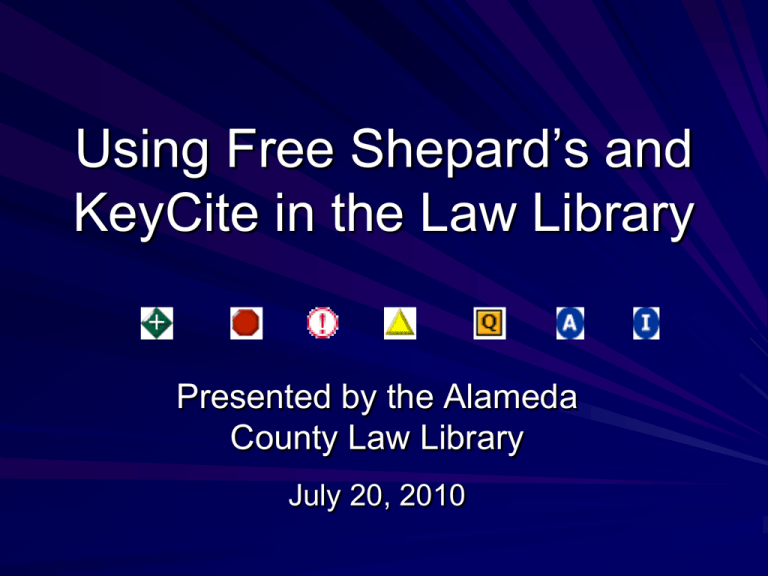
Using Free Shepard’s and KeyCite in the Law Library Presented by the Alameda County Law Library July 20, 2010 Free at the Law Library! The Alameda County Law Library provides library users free access to subscription citation verification services Shepard’s and Keycite on patron terminals at the Main and Branch libraries. Reference Librarians are always available at both locations to provide one-on-one assistance in the effective use of these services. What is Shepardizing? Accessed through the LexisNexis platform, Shepard’s Citation Service is a citation verification tool that allows researchers to “update” a legal authority by generating a Shepard’s Report. Shepard’s is most commonly used to determine the continuing precedential value of cases. What is Shepardizing? cont’d. A Shepard’s Report presents both the direct history of the authority you are updating and a complete list of citing references, including: Primary sources: Cases, statutes, and regulations that cite to the authority, potentially affecting its precedential or authoritative value. Secondary sources: A selective list that cite to your authority, offering discussion of its significance. Based on favorable or unfavorable treatment by later authorities, editors at LexisNexis assign primary authorities a “Shepard’s signal,” included in the Shepard’s Report to quickly indicate to researchers the current strength of the authority, as perceived by Lexis editors. What Can Be Shepardized? Case law Statutory citations Regulations Constitutional provisions Court rules Agency decisions Restatements Law review articles U.S. patents Why Is Shepardizing Useful? Shepardizing serves two major functions, allowing attorneys and litigants: To validate legal authorities and comply with the duty to present “good law” to the court. To identify additional, related authorities that support their argument. Duty to Present “Good Law” It is an attorney’s professional responsibility to present “good law” to the court, supporting their arguments in motions and briefs with citations to valid legal authorities. Rule 5-200(D) of the California Rules of Professional Conduct states: “[An attorney] Shall not, knowing its invalidity, cite as authority a decision that has been overruled or a statute that has been repealed or declared unconstitutional;” Citing to authorities that are no longer considered good law can result in an attorney being embarrassed or reprimanded by the judge. Shepardizing is a critical step in the research process. Solution? = Shepardize! Attorneys can meet this obligation to the court by updating their authorities with a citation verification service like Shepard’s. Information contained in a Shepard’s Report enables an attorney or litigant to: Determine if the authority has received positive or negative treatment from citing authorities, strengthening or weakening its precedential or authoritative value. Draw conclusions about the continuing precedential, persuasive or authoritative value of the authority for the issue they are researching. Secondary Function: Identify Additional Authorities Listing all primary and secondary sources that have cited to your authority, a Shepard’s Report also serves as an excellent point of departure for further research. Identify and review additional cases with similar issues. Review secondary sources, including Restatements, treatises, law reviews, and court documents that have analyzed or interpreted your authority. Advantages of Shepard’s Online Interface Faster, less cumbersome to use than the print version Hyperlink quickly to the full-text of the original citation and any citing references Customize your report Most up-to-date content available Multiple content delivery options Before You Shepardize: Identify the Proper Citation Format To Shepardize a citation, it must be entered in a format recognized by Shepard’s. Users can look up the proper citation format of a primary or secondary source by clicking on the “Citation Formats” hyperlink next to the search box. This will open the “Citation Format Assistant” in which you will enter the name of the publication to retrieve the recognized citation format. Let’s Shepardize!: Shepardizing a Case Select the “Shepard’s for Research” option and click “Check” to generate a Shepard’s Report that includes the direct history of the case along with all citing references. Smith v. Lewis 13 Cal. 3d. 349 (1975) Shepard’s Report at a Glance Smith v. Lewis 13 Cal. 3d. 349 (1975) Elements of a Shepard’s Report Shepard’s Summary Prior History Citing Decisions Other Sources Shepard’s Summary Shepard’s Summary provides a snapshot of the Shepard’s Report: -Shepard’s signal -Hyperlinks to Citing References, both: - Citing cases: organized by analysis type and treatment notation - Other sources: law reviews, secondary sources, statutes, treatises, court documents that reference your case. -Hyperlinks to LexisNexis Headnotes Smith v. Lewis 13 Cal. 3d. 349 (1975) Shepard’s Signals Demystified What do the Shepard’s signals mean? Assigned by Lexis editors after reviewing positive, neutral and/or negative treatment of your citation by later authorities, Shepard’s signals are meant to provide an overall indication of the strength of your authority. Serve as a “First Alert” to the researcher concerning the possible precedential value of the authority. Analytical Treatment Notations Assigned by Lexis editors to citing cases that may affect the precedential value of the Shepardized case, indicating treatment by the citing authority. Affirmed: On appeal, reconsideration, or rehearing, the citing case affirms or adheres to the reasoning employed by the cited case. Followed: The citing case relies on the cited case as controlling or persuasive authority. Explained: The citing case explains or interprets the reasoning or holding of the cited case. Distinguished: The citing case differs from the cited case in either fact situation or legal issue. Criticized: The citing case criticizes some aspect of the cited case, although the citing court may not have the authority to affect its precedential value. Questioned: The citing case questions the continuing validity or precedential value of the cited case because of intervening circumstances, such as judicial or legislative overruling. Overruled: The citing case overrules all or part of the cited case. Reversed: On appeal, reconsideration, or rehearing, the citing case reverses the cited case. Prior History Includes both the prior case history and subsequent appellate history of the case you have Shepardized (direct history). Smith v. Lewis 13 Cal. 3d. 349 (1975) Citing Decisions Organized by court, then by date, with the most recent decisions from the highest court displayed first. Full citations of citing decisions are given along with pinpoint citations to the specific page(s) in each citing decision where the Shepardized case is referenced. Analytical treatment notations indicate treatment by citing cases. Smith v. Lewis 13 Cal. 3d. 349 (1975) CAUTION: Review Citing Cases Though the Shepard’s signals and analytical treatment notations provide some indication of the precedential value of a case or other authority, researchers must not rely on these editorial treatments as the “final word” concerning the continuing validity of a case. • ex: a case flagged overruled may only be overruled for a single point of law. It is imperative that the researcher carefully review any citing cases that indicate negative treatment and reach their own conclusion about the precedential value of the case for the legal issue they are researching. Use pinpoint citations to quickly locate the specific passage(s) where citing decisions make reference to your case. Citing Non-Case Authorities Review non-case authorities that have cited your case, including annotated statutes, regulations, and agency decisions. Smith v. Lewis 13 Cal. 3d. 349 (1975) Citing Secondary Sources Review secondary sources, including law reviews, Restatements, treatises and court documents that have discussed or interpreted your case. •How have legal scholars regarded your case? Smith v. Lewis 13 Cal. 3d. 349 (1975) Customize Your Report Depending on how influential or controversial your case has been, hundreds of even thousands of citing references may appear in your Shepard’s Report. Attempting to review all the cases and secondary sources that have cited to your case, including those from other jurisdictions or those that discuss a different point of law than you are researching, is inefficient, and most likely unnecessary. Shepard’s allows users to manipulate their results’ list by placing limits on the report, reducing the total number of citing references displayed and presenting results in a way that is more meaningful and useful to the researcher. Smith v. Lewis 13 Cal. 3d. 349 (1975) Customize Your Report cont’d. Generate a targeted results’ list by limiting your Shepard’s Report by: Treatment FOCUS Feature Smith v. Lewis 13 Cal. 3d. 349 (1975) Treatment Limiting by treatment allows you to restrict results by analysis type. – All Neg: Displays citing cases that have overruled, reversed, questioned, distinguished, criticized, or limited the case you are Shepardizing for at least one point of law. – All Pos: Displays citing cases that have affirmed or followed the case’s legal reasoning. FOCUS Feature Use the FOCUS feature to narrow your results by: Jurisdiction: display only those citing references from one or more specific jurisdictions Search Terms: display only those citing references in which a particular term or phrase appears Date Range: display only those citing references published during a specific date range Headnote(s): display only those citing references that contain a specific headnote(s). – Allows you to retrieve citing cases that include discussion of a specific legal issue/application of a particular point of law. Focus Feature cont’d. Select limits. Click “Apply” to generate a FOCUSed report. FOCUSing by Headnote Zero in on relevant cases quickly by limiting your Shepard’s report to cases that contain a specific headnote. A headnote is a brief summary of a particular point of law that is added to the text of a court decision to aid readers in interpreting the highlights of the opinion. Smith v. Lewis 13 Cal. 3d. 349 (1975) Shepard’s Table of Authorties (TOA) Lists the cases relied on by the case you Shepardized, organized by jurisdiction. – Use this feature to discover hidden weaknesses in your case by reviewing the strength of its foundation. View Full-Text of Authorities View the full-text of the authority you Shepardized or any citing reference in your Shepard’s Report by clicking on the hyperlinked citation. Select the documents for print or email delivery, or save to a flash drive. Smith v. Lewis 13 Cal. 3d. 349 (1975) Shepardizing Statutes Shepardizing a code section yields information about its legislative history and citing references, including citing decisions and secondary sources. Elements of a Shepard’s Report for Statutes: Shepard’s Summary History Citing Decisions Other Sources Let’s Shepardize! 29 U.S.C. sec. 2612 Shepard’s Summary for Statutes Shepard’s Signal Indicator: Assigned by Lexis editors based on negative, positive, or neutral treatment by citing authorities. Pending Legislation: Signal alerting that a bill pending in the legislature proposes to amend, repeal, or enact a change to the code section you have Shepardized. Hyperlinks to Citing References, both: - Citing cases: organized by analysis type and treatment notation - Other sources: law reviews, secondary sources, statutes, treatises, court documents that reference the code section 29 U.S.C. sec. 2612 History The report’s “History” section provides derivation information, listing statutes that have added, amended, superseded or repealed the Shepardized code section. Click the hyperlinks to read the full-text of the public law or Statutes at Large citation. The report’s “Pending Legislation” section lists bills pending in the legislature that propose to amend, repeal, or enact a change to the code section you are Shepardizing Citing Decisions Review citing decisions to determine how your code section has been applied or interpreted by the courts, possibly affecting its validity. Organized by court, then by date, full case citations are given along with pinpoint citations to where the citing decision references the Shepardized code section. Analytical treatment notations for statutes indicate treatment by citing cases: – – – Warning Analyses: Unconstitutional, Invalid, Void Positive Analyses: Constitutional, Valid, Followed Neutral Analyses: Construes, Interprets, Questionable Precedent, Dissenting Opinion 29 U.S.C. sec. 2612 Other Sources Review non-case authorities that have cited your code section, including other statutes, regulations, court documents, and law review articles. Determine how agencies have implemented the statute by reviewing citing regulations. 29 U.S.C. sec. 2612 Content Delivery Options From law library computers, three content delivery options are available for the Shepard’s Report, the full-text of your original citation, and any citing references included in the report: Print Delivery (.25 cents/page) Email Delivery (free of charge) Save to a Flash Drive (free of charge) Refer to handouts for step-by-step instructions for using each delivery method. HAVE FUN SHEPARDIZING! ASK REFERENCE LIBRARIANS FOR ASSISTANCE! Print Delivery 1. Select the printer icon 2. Select the documents you want to print under the heading “Document Range.” 3. Generate a PDF document by selecting “Adobe PDF for Attached Printer” and hitting the “Print” button. Print Delivery cont’d. 3. On the PDF document that is generated, select the white printer button in the upper left-hand corner to bring up the Print Dialog Box. 4. When the Print Dialog Box appears, click “Ok” to send the entire document to the library printer, or specify the page range you would like to print. Retrieve print-outs at the Reference Desk. Remember, printing costs .25 cents/page! Email Delivery 1. Select the letter icon to bring up the email dialog box. 2. Type your email address in the “Email Documents” dialog box and select the documents you want to email to yourself and the format in which you want them sent (Word, PDF, Word Perfect, txt, rtf). 3. Select the “Send” button to email the documents in the format specified. Save to Flash/USB Drive 1. Insert flash drive into USB port. (Flash drive cannot contain executables). 2. Select the diskette icon to bring up the “Download Documents” dialog box. 3. Select the documents you want to save and the format in which you want to download them (Word, PDF, Word Perfect, txt, rtf). 4. Select “Download” to generate the documents in the format specified. Save to Flash/USB Drive cont’d. 4. The “Ready to Download” box will appear. 5. Click on hyperlinked citation to open the document in the format specified. 6. On the PDF document that is generated, select the diskette icon to save the document. Save to Flash/USB Drive cont’d. 7. In the “Save a Copy” dialog box, double click on “usb drive.” 8. Enter a document name in the File Name field and click “Save.”

